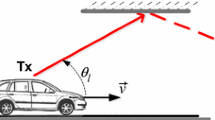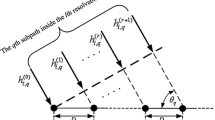Abstract
In this paper, we present a new Doppler spread estimation algorithm for broadband wireless orthogonal frequency division multiplexing (OFDM) systems with fast time-varying and frequency-selective Rayleigh or Rician fading channels. The new algorithm is developed by analyzing the statistical properties of the power of the received OFDM signal in the time domain, thus it is not affected by the influence of frequency-domain inter-carrier interference (ICI) introduced by channel variation within one OFDM symbol. The operation of the algorithm doesn’t require the knowledge of fading channel coefficients, transmitted data, or signal-to-noise ratio (SNR) at the receiver. It is robust against additive noise, and can provide accurate Doppler spread estimation with SNR as low as 0 dB. Moreover, unlike existing algorithms, the proposed algorithm takes into account the inter-tap correlation of the discrete-time channel representation, as is the case in practical systems. Simulation results demonstrate that this new algorithm can accurately estimate a wide range of Doppler spread with low estimation latency and high computational efficiency.






Similar content being viewed by others
References
IEEE Standard for Wireless LAN Medium Access Control (MAC) and Physical Layer (PHY) Specifications, IEEE Std. 802.11g-2003, June 2003.
Digital Video Broadcasting (DVB): Transmission System for Handheld Terminals (DVB-H), ETSI Std. EN 302 304, Nov. 2004.
IEEE Standard for Local and Metropolitan Area Networks—Part 16: Air Interface for Fixed and Mobile Broadband Wireless Access Systems, IEEE Std. 802.16e-2006, Feb. 2006.
T. Zahariadis, Trends in the path to 4G, IEEE Communincation Engineering, Vol. 14, No. 1, pp. 12–15, 2003.
R. Prasad, OFDM for Wireless Communication Systems, Artech House, 2004.
A. Stamoulis, S. N. Diggavi, and N. Al-Dhahir, Intercarrier interference in MIMO OFDM, IEEE Transactions on Signal Processing, Vol. 50, No. 10, pp. 2451–2464, 2002.
M. Speth, S. A. Fechtel, G. Fock, and H. Meyr, Optimum receiver design for wireless broad-band systems using OFDM–Part I, IEEE Transactions on Communications, Vol. 47, No. 11, pp. 1668–1677, 1999.
P. Schniter, Low-complexity equalization of OFDM in doubly selective channels, IEEE Transactions on Signal Processing, Vol. 52, No. 4, pp. 1002–1011, 2004.
C. Tepedelenlioglu, A. Abdi, G. Giannakis, and M. Kaveh, Estimation of Doppler spread and signal strength in mobile communications with applications to handoff and adaptive transmission, Wireless Commnunication and Mobile Computing, Vol. 1, pp. 221–242, 2001.
J. Zhang, Q. Zhang, B. Li, X. Luo, and W. Zhu, Energy-efficient routing in mobile ad hoc networks: mobility-assisted case, IEEE Transactions On Vehicular Technology, Vol. 55, No. 1, pp. 369–379, 2006.
A. D. Assouma, R. Beaubrun, and S. Piere, Mobility management in heterogeneous wireless networks, IEEE Journal on Selected Areas in Communications, Vol. 24, No. 3, pp. 638–648, 2006.
P. N. Pathirana, A. V. Savhin, and S. Jha, Location estimation and trajectory prediction for cellular networks with mobile base stations, IEEE Transactions on Vehicular Technology, Vol. 53, No. 6, pp. 1903–1913, 2004.
H. Schober, F. Jondral, R. Stirling-Gallacher, and Z. Wang, Adaptive channel estimation for OFDM based high speed mobile communication systems, in Proc. IEEE International Conference on 3rd Generation Wireless and Beyond, San Francisco, USA, June 2001, pp. 392–397.
R. C. Cannizzaro, P. Banelli, and G. Leus, Adaptive channel estimation for OFDM systems with Doppler spread, in Proc. IEEE SPAWC’06, July 2006, pp. 1–5.
J. Oh and J. M. Cioffi, Sub-band rate and power control for wireless OFDM systems, in Proc. IEEE VTC’04, Sept. 2004, pp. 2011–2014.
K. B. Song, A. Ekbal, S. T. Chung, and J. M. Cioffi, Adaptive modulation and coding (AMC) for bit-interleaved coded OFDM (BIC-OFDM), IEEE Transactions on Wireless Communications, Vol. 5, No. 7, pp. 1685–1694, 2006.
M. D. Austin and G. L. Stuber, Velocity adaptive handoff algorithms for microcellular systems, IEEE Transactions on Vehicular Technology, Vol. 43, No. 3, pp. 549–561, 1994.
R. Narasimhan and D. C. Cox, Speed estimation in wireless systems using wavelets, IEEE Transaction on Communications, Vol. 47, No. 9, pp. 1357–1364, 1999.
C. Xiao, K. D. Mann, and J. C. Olivier, Mobile speed estimation for TDMA-based hierachical cellular systems, IEEE Transactions on Vehicular Technology, Vol. 50, No. 4, pp. 981–991, 2001.
C. Xiao, Estimating velocity of mobiles in EDGE systems, in Proc. IEEE ICC’02, Apr. 2002, pp. 3240–3244.
G. Azemi, B. Senajij, and B. Boashash, Mobile unit velocity estimation based on the instantaneous frequecny of the received signal, IEEE Transactions on Vehicular Technology, Vol. 53, No. 3, pp. 716–724, 2004.
L. Zhao and J. W. Mark, Mobile speed estimation based on average fade slope duration, IEEE Transaction on Communications, Vol. 52, No. 12, pp. 2066–2069, 2004.
G. Park, S. Nam, T. Yu, D. Hong, and C. Kang, A modified covariance-based mobile velocity estimation method for Rician fading channels, IEEE Communications Letters, Vol. 9, No. 8, pp. 706–708, 2005.
S. Mohanty, VEPSD: a novel velocity estimation algorithm for next-generation wireless systems, IEEE Transactions on Wireless Communications, Vol. 4, No. 6, pp. 2655–2660, 2005.
K. E. Baddour and N. C. Beaulieu, Robust Doppler spread estimation in nonisotropic fading channels, IEEE Transactions on Wireless Communications, Vol. 4, No. 6, pp. 2677–2682, 2005.
Y. R. Zheng and C. Xiao, Mobile speed estimation for broadband wireless communications over Rician fading channels, IEEE Transactions on Wireless Communications, Vol. 8, pp. 1–5, 2009.
H. Schober and F. Jondral, Velocity estimation for OFDM based communication systems, in Proc. IEEE VTC’02, Sept. 2002, pp. 715–718.
T. Yucek, R. M. A. Tannious, and H. Arslan, Doppler spread estimation for wireless OFDM systems, in Proc. IEEE/Sarnoff Symposium on Advances in Wired and Wireless Communication, Apr. 2005, pp. 233–236.
J. Cai, W. Song, and Z. Li, Doppler spread estimation for mobile OFDM systems in Rayleigh fading channels, IEEE Transactions on Consumer Electronics, Vol. 49, No. 4, pp. 973–977, 2003.
A. Doukas and G. Kalivas, Doppler spread estimation in frequency selective Rayleigh channels for OFDM systems, in Proc. 5th International Symposium in Communication Systems, Networks and Digital Signal Processing, Patras, Greece, July 2006.
A. J. Paulraj, R. Nabar, and D. Gore, Introduction to Space-Time Wireless Communications, Cambridge University Press, 2003.
C. Xiao, J. Wu, S. Y. Leong, Y. R. Zheng, and K. B. Letaief, A discrete-time model for triply selective MIMO Rayleigh fading channel, IEEE Transactions on Wireless Communications, Vol. 3, No. 5, pp. 1678–1688, 2004.
Y. R. Zheng and C. Xiao Novel sum-of-sinusoids simulation models for Rayleigh and Rician fading channel, IEEE Transactions on Wireless Communications, Vol. 5, No. 12, pp. 3667–3679, 2006.
P. A. Bello, Characterization of randomly time-variant linear channels , IEEE Transactions on Communications Systems, Vol. 11, No. 4, pp. 360–393, 1963.
Acknowledgement
This work was supported in part by the National Science Foundation under Grants CCF-0832833, CCF-0915846 and ECCS-0917041.
Author information
Authors and Affiliations
Corresponding author
Appendix
Appendix
1.1 Proof of (8) and (9)
The auto-correlation function of the received time-domain OFDM signal is calculated as
where x (i)(n) defined in (1) is used in the derivation of the last equality, thus (8) is proved.
The proof of Eq. 9 relies on the following two identities: \({\mathbb E}\{v_1v_2v_3\}=0\) and \({\mathbb E}\{v_1v_2v_3v_4\}={\mathbb E}\{v_1v_2\}{\mathbb E}\{v_3v_4\}+{\mathbb E}\{v_1v_3\}{\mathbb E}\{v_2v_4\}+{\mathbb E}\{v_1v_4\}{\mathbb E}\{v_2v_3\},\) where \(v_1, v_2, v_3\) and v 4 are zero-mean Gaussian random variables. With the above identities, (9) can be derived based on the definition of auto-covariance function. The derivation process is extremely lengthy and tedious, but straightforward, thus the details are omitted here for brevity.
Rights and permissions
About this article
Cite this article
Tao, J., Wu, J. & Xiao, C. Doppler Spread Estimation for Broadband Wireless OFDM Systems Over Rician Fading Channels. Int J Wireless Inf Networks 16, 197–208 (2009). https://doi.org/10.1007/s10776-009-0108-y
Published:
Issue Date:
DOI: https://doi.org/10.1007/s10776-009-0108-y




